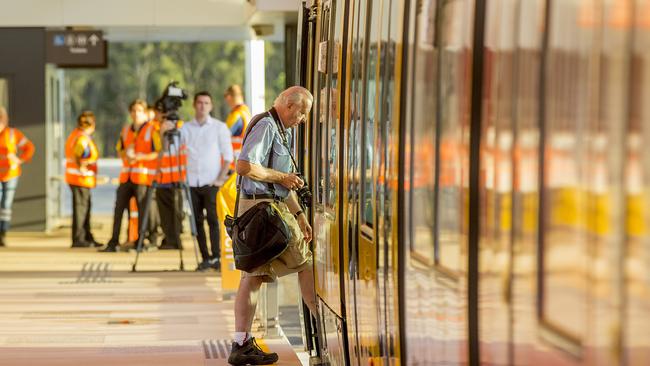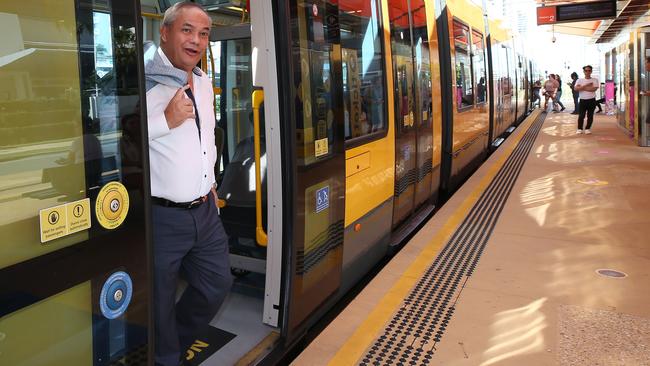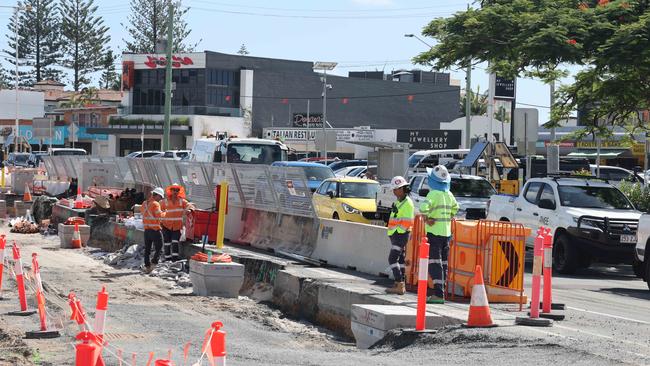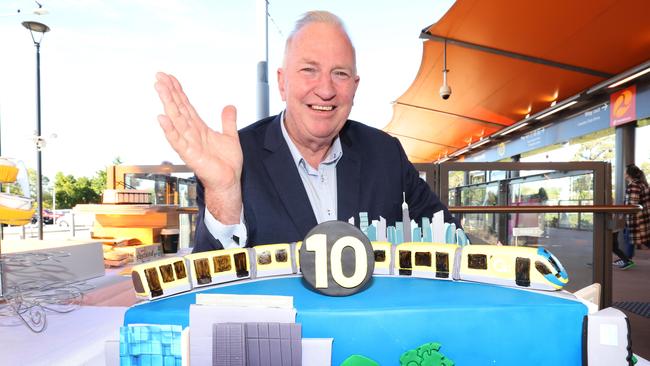Gold Coast Mayor Tom Tate argues the case for light rail to be extended south to the airport
OPINION The ultimate ‘survey’ on light rail has been local elections. Since 2014 when light rail commenced, no incumbent councillor who has publicly backed light rail has ever lost.
Gold Coast
Don't miss out on the headlines from Gold Coast. Followed categories will be added to My News.
OPINION When asked about public transport on the southern Gold Coast the Premier David Crisafulli has said “doing nothing is not an option”.
For the past 13 years, successive councils have debated, negotiated and endorsed city-wide transport strategies to address the growing population on the Gold Coast.
These transport strategies have been widely circulated among the community, supported by public consultation, community hall meetings, stakeholder workshops and surveys. Hearing the views of all Gold Coasters has been essential as ultimately, everyone has a stake in transport systems and technology as we are ‘all system users’.
In finalising our City Transport Strategy, proposed modes of transport, routes and design works have been meticulously brought together by highly experienced traffic and transport engineers. This has never been about ‘guess work’ and the current City Transport Strategy has won numerous national awards.
Since 2014, when light rail first started on the Gold Coast, every adaptation of our City Transport Strategy has had at its core, the focus from all three levels of government that light rail would evolve to become the transport ‘spine’ of the city. As part of the overall strategy, components such as high-speed bus services, possible future light rail spur lines, improved local road networks and expanded cycle and pedestrian ways have all been mapped out, and delivered, over the past decade. The strategy is a public document on our City website.
Importantly, when light rail stage one opened in 2014, running from Griffith University Hospital to Broadbeach, all three tiers of government agreed that the long-term plan was to link light rail with heavy rail at Helensvale (stage two), Broadbeach with Burleigh (stage three) and the final stage linking Burleigh with the airport and Coolangatta (stage 4). Those works would complete the ‘spine’ and give this generation of Gold Coasters, and the next, a reliable, seamless transport corridor from Helensvale to the border.

Successive state and federal governments signed off on the design and funding models for stages 1, 2 and 3. Council has contributed around 11 percent for each stage with the other two tiers of government managing the rest in what was, in effect, the first “city deal” in Queensland.
Since 2014, light rail has exceeded all expectations for passenger numbers (almost 100 million paying passengers to date); it has been integral in moving large volumes of locals and tourists during major events; it has improved the lifestyle of thousands of people who don’t have access to private vehicles; it has given people with mobility issues a safe and seamless transport mode to places like Gold Coast University Hospital; and it has shown locals and visitors that we are a world-class city built on smart transport solutions.
Governments change and the people of Queensland elected the LNP in 2024. After nine years out of office, I respect the Government’s right to review Gold Coast public transport and I gave the Premier my word that I would retain an open mind about the outcome.
I’m the first to say that the implementation of the project, particularly stages 1 and 3, has by no means been perfect. That said, the ultimate results after that pain have been outstanding and I still firmly believe that finishing the project to the airport is the clear preference and indeed will give the city and the State and Federal Governments the greatest return on investment by linking the heavy rail, light rail and airport.

In recent days there has been significant media interest in the market research the council conducted in December 2024 and the recently released State Government “have your say” survey. I’m all for community surveys but the intent of any community survey must be to end up with accurate data. Otherwise, what’s the point?
The current State Government ‘community consultation’ on light rail stage 4 seriously risks eroding the endorsed Gold Coast Transport Strategy which has been the blueprint for billions of dollars of public investment to date in community transport because it is flawed from the outset.
Firstly, the State has said the opinions of people in the “southern Gold Coast’’ will be given more weight than others. Why? How? That is completely unfair as every Gold Coaster has seen their ratepayer dollars invested in public transport for all Gold Coasters so why should a survey respondent in Palm Beach be given more credibility than a ratepayer in Ashmore about completing this whole of city project?
Light rail is not a public transport mode just for southern residents. It is a city-wide investment for all Gold Coasters. More Gold Coasters use light rail than tourists and Gold Coasters want further options for how they access their airport and our beautiful southern suburbs and beaches.
Secondly whilst this survey was purported as the first “genuine consultation’’ with people in southern Gold Coast, the original design of the survey opens up the data to corrupt entries and phantom responses. There now seems to be a requirement to register before you can complete the survey but that was only added after thousands of responses had already been received.
Thirdly, the four questions in the survey offer no alternative public transport modes or routes, between Burleigh and the airport; and fails to ask respondents’ ages, genders, employment status or if they use public transport in any form.
The survey does ask the respondent for their street address (street name only, not number) but does not ask for proof of that address.
But here’s the real issue. As a precursor to the launch of the survey on March 21, the State Government publicly stated more than 1000 existing carparks and 235 properties in the stage 4 corridor were at risk under the current proposed light rail stage route. People now completing the survey, with those alarmist comments in their minds, will likely call for an end to light rail. Perhaps the government has more recent information from Transport and Main Roads but the last advice I received suggested 78 resumptions. As for the car parks, Council and the State Government own significant land along the light rail Stage 4 route that would be ideal for car parks and park and ride facilities to replace other car parks lost. I identified those opportunities before the last local government elections and I am committed to delivering them but obviously neither the city, nor the State, would go to that expense until we are certain the project will proceed. In short, the alarm created over loss of car parks is misleading to say the least.

The fact is, the State Government and Council are currently working to finalise the detailed business case for stage 4. That business case is not complete and won’t be for some months so no government official, elected or otherwise, could have seen the report which will finalise the specifics on resumptions, car parking and the actual cost of light rail stage 4.
So whilst I respect the Government’s right to have another look at public transport on the Gold Coast I have to be honest and say the process they are using via the current survey is flawed and open to criticism.
If this survey produces a result which claims the majority of “southern Gold Coasters’’ want buses instead of light rail, does that mean our city’s entire transport strategy is redundant?
How have we reached the situation where a small minority of light rail opponents can make a decision which impacts the lives of 500,000-plus other residents?
How have we arrived at the point where this survey will determine the way current and future generations move about their city? Light rail is not a ‘tourist train’. It is for locals first and foremost. Every properly-formatted and circulated city-wide survey conducted by council over the last decade has shown the majority are pro light rail.

From a council perspective, community consultation is nothing new. When our council proposes new projects or initiatives, we consult widely. In every way, consultation is part of our core business and is enshrined in legislation, meaning it is not a ‘nice-to-have’ – it is essential. One example is the annual City Budget Survey, attracting 6138 respondents in 2024-25.
To ensure the data compiled through our surveys is valid, we adopt the internationally-recognised process known as IAP2. The current State Government survey abides by none of the IAP2 standards.
IAP2 is not a buzz term. It is recognised and adopted by hundreds of local, state and federal government agencies. The core values of IAP2 are: that public participation is based on the belief that those who are affected by a decision have a right to be involved in the decision-making process; public participation includes the promise that the public’s contribution will influence the decision; that public participation promotes sustainable decisions by recognising and communicating the needs and interests of all participants, including decision makers; public participation seeks out and facilitates the involvement of those potentially affected by or interested in a decision; public participation seeks input from participants in designing how they participate; public participation provides participants with the information they need to participate in a meaningful way; public participation communicates to participants how their input affected the decision.
The State Government survey, doesn’t meet any IAP2 standard. It simply asks the following:
How would you describe a great public transport system for your local area?
What are your concerns on the current proposal for light rail expansion in the southern Gold Coast?
Do you feel that you were properly consulted in the prior process?
In your opinion, what key features or services are important to consider for developing a great public transport system in your local area?

Residents are then asked to rank whether affordability, accessibility, frequency, or proximity is most important when considering public transport options.
That’s it. And remember, the State has publicly stated the views of southern residents will be given more consideration than someone in Ashmore or Parkwood. Pretty unfair when you consider the Ashmore and Parkwood residents have contributed the same amount of their ratepayer funds towards city-wide public transport as someone in Palm Beach or Tugun.
What has been lost in this debate is that light rail has been a huge success. It is universally seen as a safer, more reliable and preferable form of public transport over buses. That’s not an opinion, it is a fact reinforced through countless public transport surveys across other states and territories including here on the coast.
Perhaps the ultimate ‘survey’ on light rail in our city has been the local government elections, held every four years. Since 2014 when light rail first commenced, no incumbent councillor who has publicly backed light rail has ever lost their seat. Last year, a vocal independent candidate in the State election for the seat of Currumbin ran her campaign almost exclusively on an anti-light rail stage 4 ticket. She received around 10 percent of the primary vote.
What is at stake here is more than a 13km section of modern public transport. It is the future of how all of us move about the Gold Coast for generations to come.
Don’t let flawed data turn the southern Gold Coast into a carpark.
More Coverage
Originally published as Gold Coast Mayor Tom Tate argues the case for light rail to be extended south to the airport




